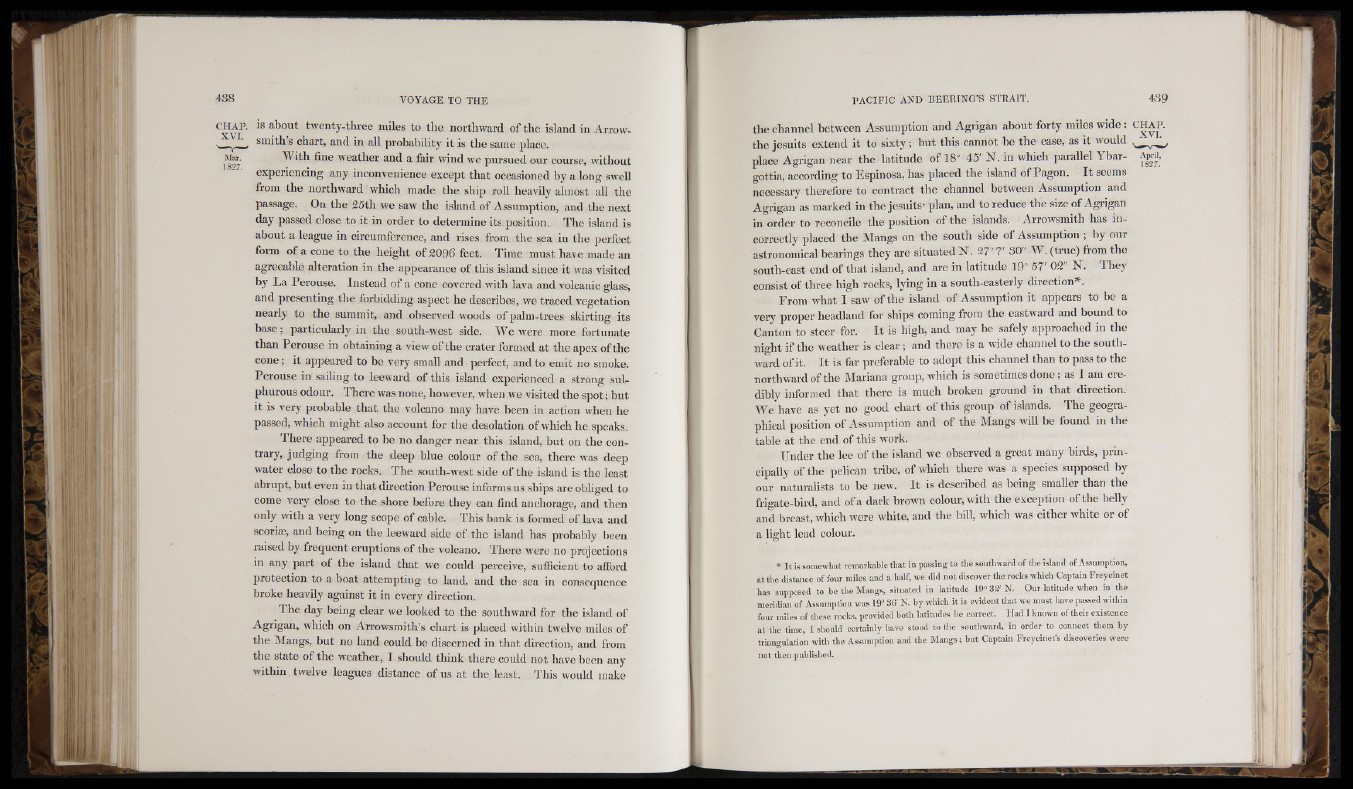
C H A P . is about twenty-three miles to the northward of the island in Arrow-
Mar.
1827.
smith s chart, and in all probability it is the same place.
With fine weather and a fair wind we pursued our course, without
experiencing any inconvenience except that occasioned by a long swell
from the northward which made the ship roll heavily almost all the
passage. On the :25th we saw the island of Assumpti on, and the next
day passed close to it in order to determine its position. The island is
about a league in eircumference, aud rises from the sea in the perfect
form of a cone to the height of 2096 feet. Time must have made an
agreeable alteration in the appearance of this island since it was visited
by La Perouse. Instead of a cone covered with lava and volcanic glass,
and presenting the forbidding aspect he describes, we traced vegetation
nearly to the summit, and observed woods of palm-trees skirting its
base; particularly in the south-west side. We were more fortunate
than Perouse in obtaining a view of the crater formed at the apex of the
cone ; it appeared to be very small and perfect, and to emit no smoke.
Perouse in sailing to leeward of this island experienced a strong sulphurous
odour. There was none, however, when we visited the spot; but
it is very probable that the volcano may have been in action when he
passed, which might also account for the desolation of which he speaks.
There appeared to be no danger near this island, but on the con-
trary, judging from the deep blue colour of the sea, there was deep
water close to the rocks. The south-west side of the island is the least
abrupt, but even in that direction Perouse informs us ships are obliged to
come very close to the shore before they can find anchorage, and then
only with a very long scope of cable. This bank is formed of lava and
scorim, and being on the leeward side of the island has probably been
raised by frequent eruptions of the volcano. There were no projections
in any part of the island that we could perceive, sufficient to afford
protection to a boat attempting to land, and the sea in consequence
broke heavily against it in every direction.
The day being clear we looked to the southward for the island of
Agrigan, which on Arrowsmith’s chart is placed within twelve miles of
the Mangs, but no land could be discerned in that direction, and from
the state of the weather, I should tliink there could not have been any
within twelve leagues distance of us at the least. This would make
llfi if :
llltî I ^ ’
the channel between Assumption and Agrigan about forty miles wide : C H A P .
the jesuits extend it to sixty ; but this cannot be the case, as it would ,
place Agrigan near the latitude of 18” 45' N . in which parallel A bar-
April,
1827.
gottia, according to Espinosa, has placed the island of Pagon. It seems
necessary therefore to contract the channel between Assumption and
Agrigan as marked in the jesuitS’ plan, and to reduce the size of Agrigan
in order to reconcile the position of the islands, Arrowsmith has incorrectly
placed the Mangs on the south side of Assumption ; by our
astronomical bearings they are situated N . 27“ 7' 30" W. (true) from the
south-east end of that island, and are in latitude 19" 57' 02" N . They
consist of three high rocks, lying in a south-easterly direction*.
From what I saw of the island of Assumption it appears to be a
very proper headland for ships coming from the eastward and bound to
Canton to steer for. It is high, and may be safely approached in the
night if the weather is clear ; and there is a wide channel to the southward
ofit. It is far preferable to adopt this channel than to pass to the
northward of the Mariana group, which is sometimes done; as I am credibly
informed that there is much broken ground in that direction.
We have as yet no good chart of this group of islands. The geographical
position of Assumption and of the Mangs will be found in the
table at the end of this work.
Under the lee of the island we observed a great many birds, principally
of the pelican tribe, of which there was a species supposed by
our naturalists to be new. It is described as being smaller than the
frigate-bird, and of a dark brown colour, with the exception of the belly
aud breast, which were white, and the bill, which was either white or of
a light lead colour.
• I t is somcwliat remarkable tliat in passing to th e southward of the island of Assumption,
a t th e distance of four miles and a half, we did not discover the rocks which Captain F rey c in e t
has supposed to be the Mangs, situated in latitude 19" 32' N. O u r latitude when in the
meridian of Assumption was 19“ 36' N. by wliich it is evident th a t we must have passed w ithin
four miles of these rocks, provided both latitudes be correct. H a d I knmvn ot tlieir existence
a t the time, I should certainly have stood to the southward, in order to connect them by
triangulation with the Assumption and the M an g s ; b u t Captain F rey c in e t’s discoveries were
not then published.